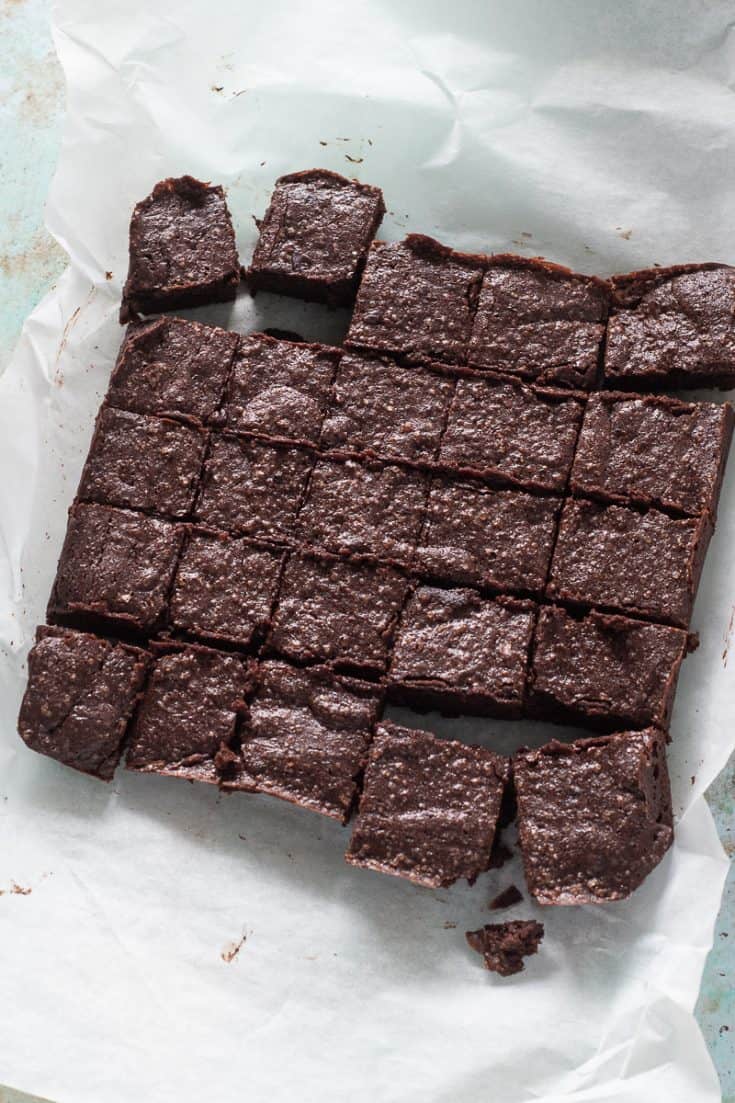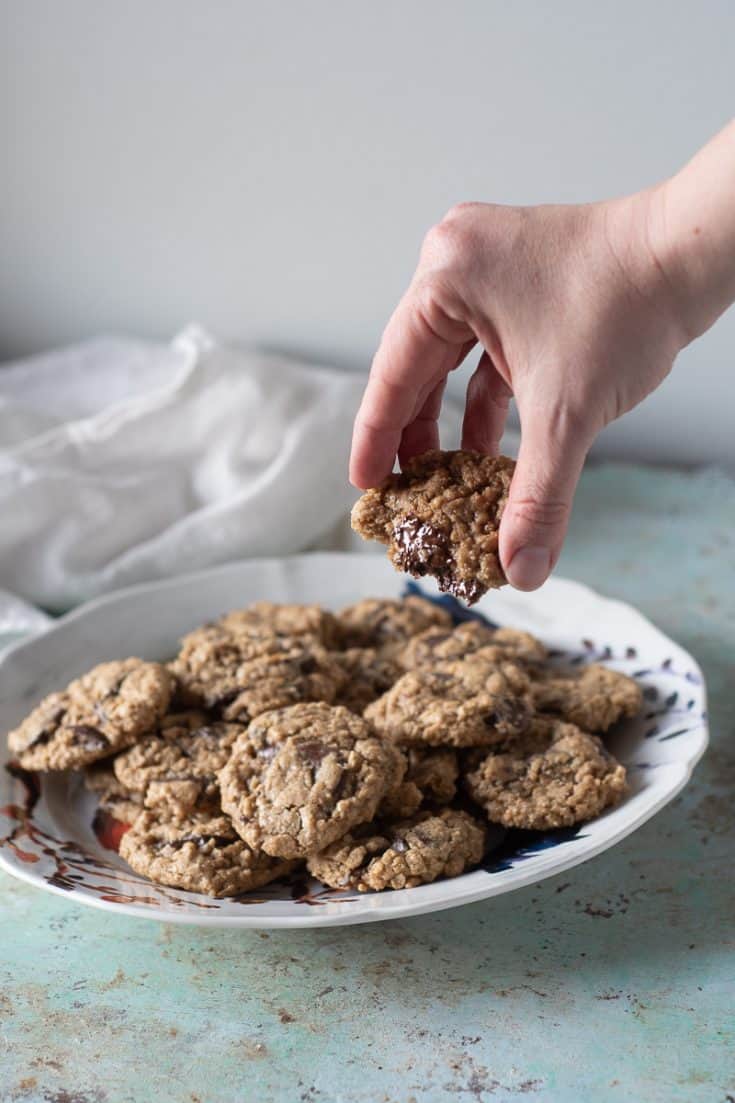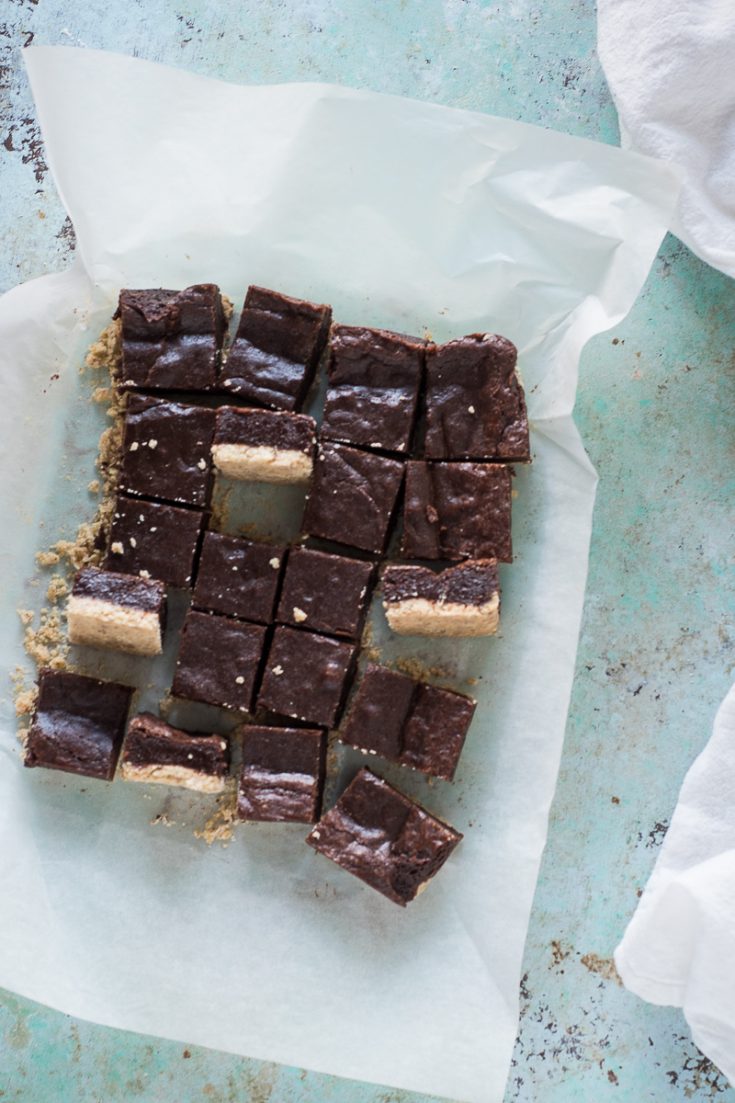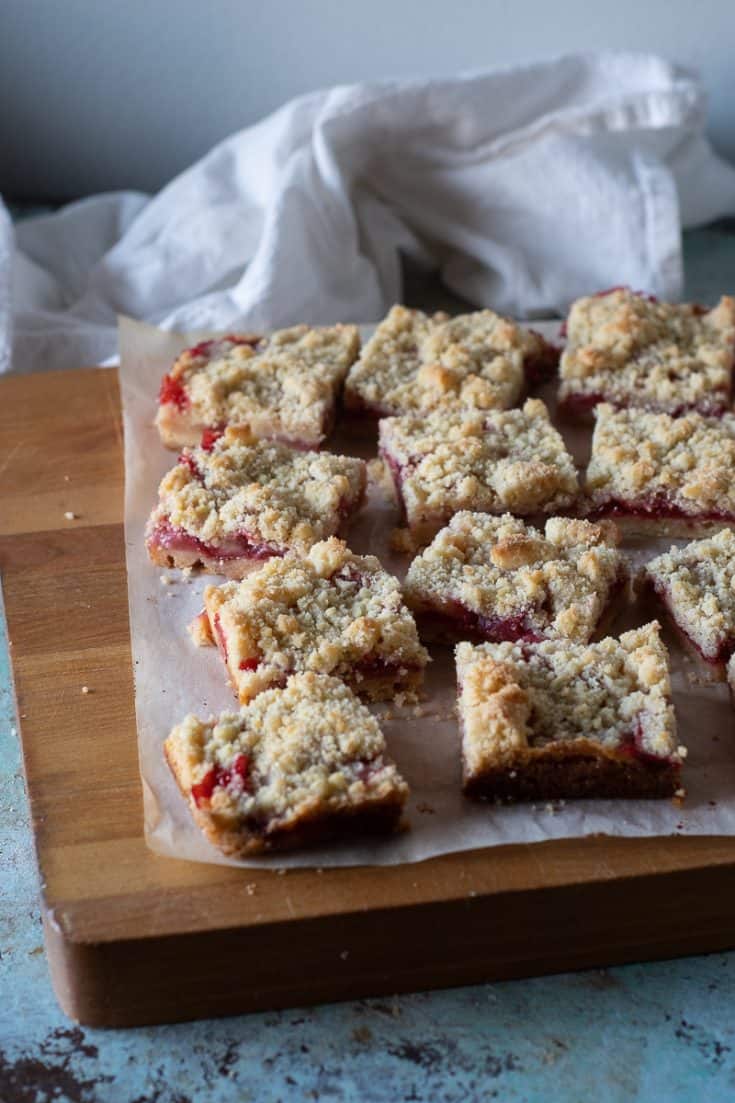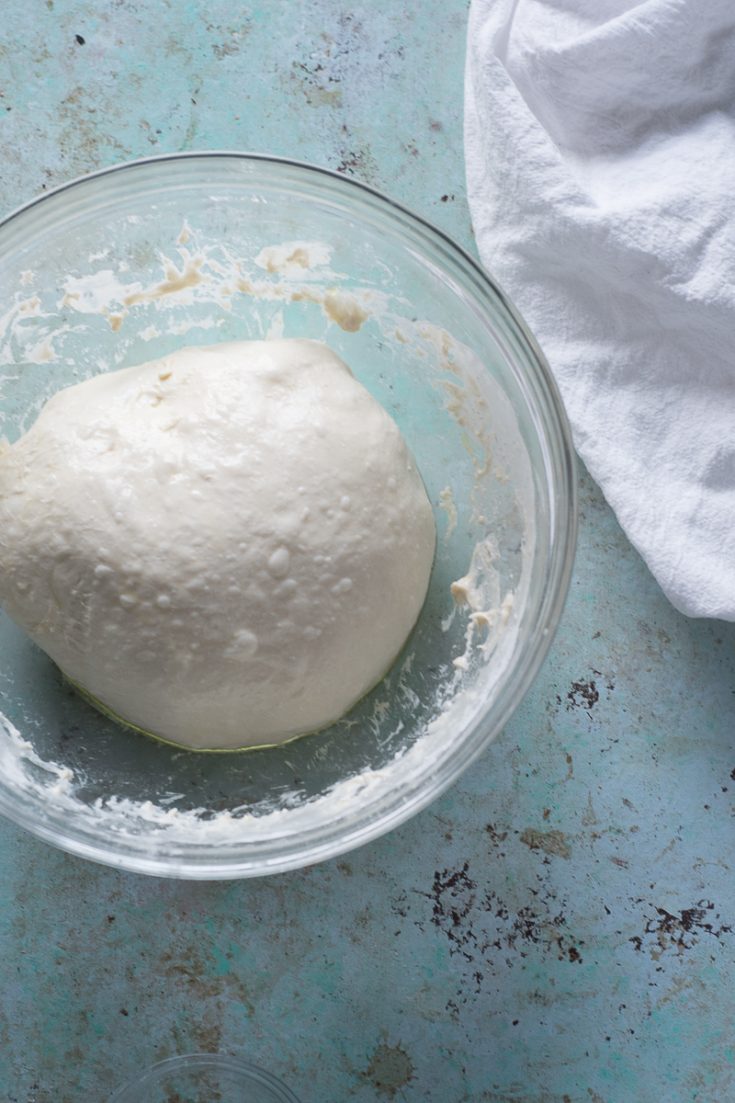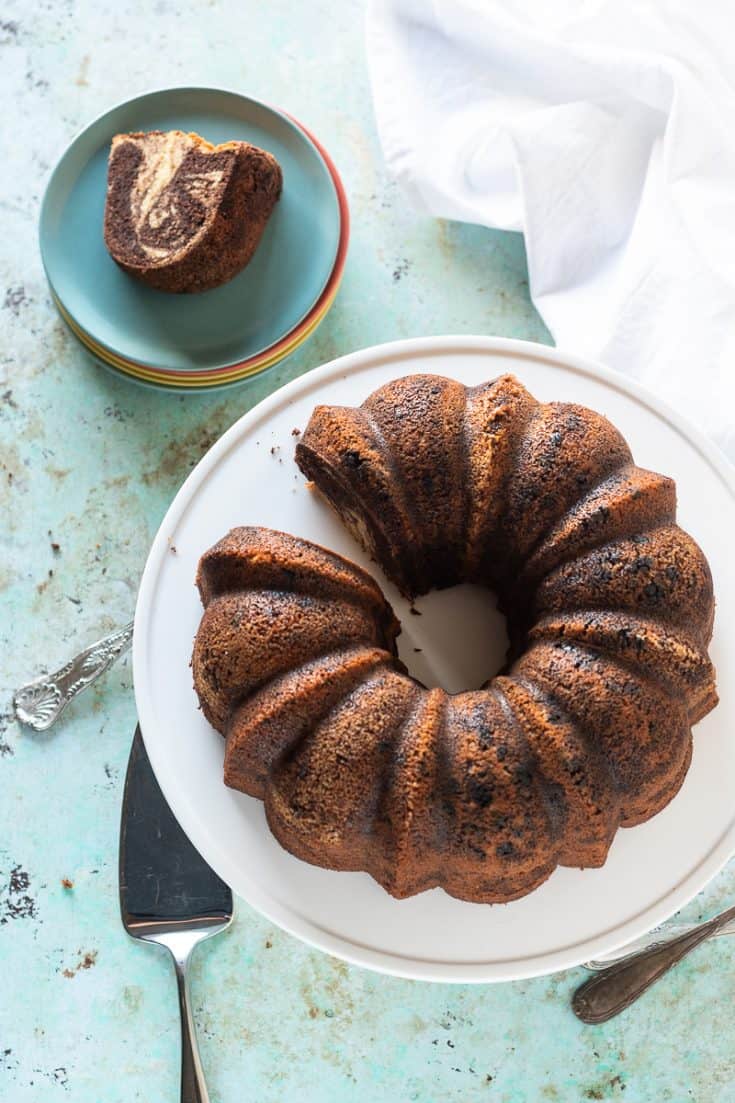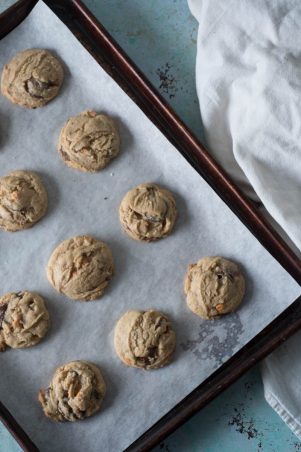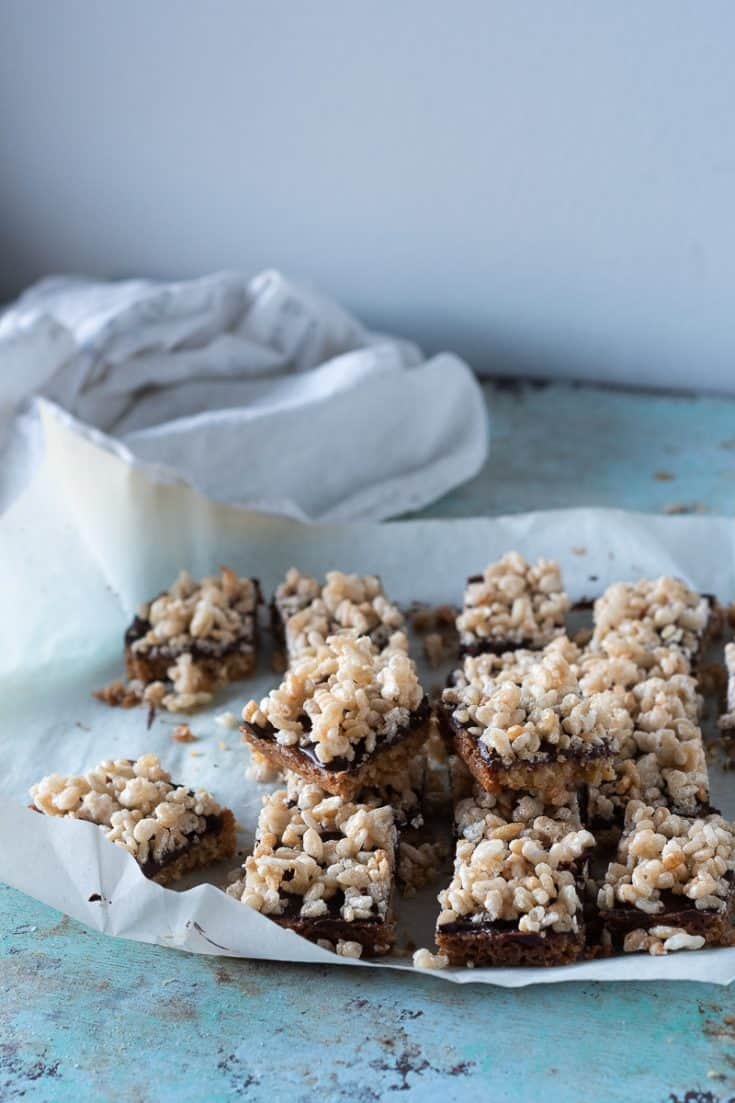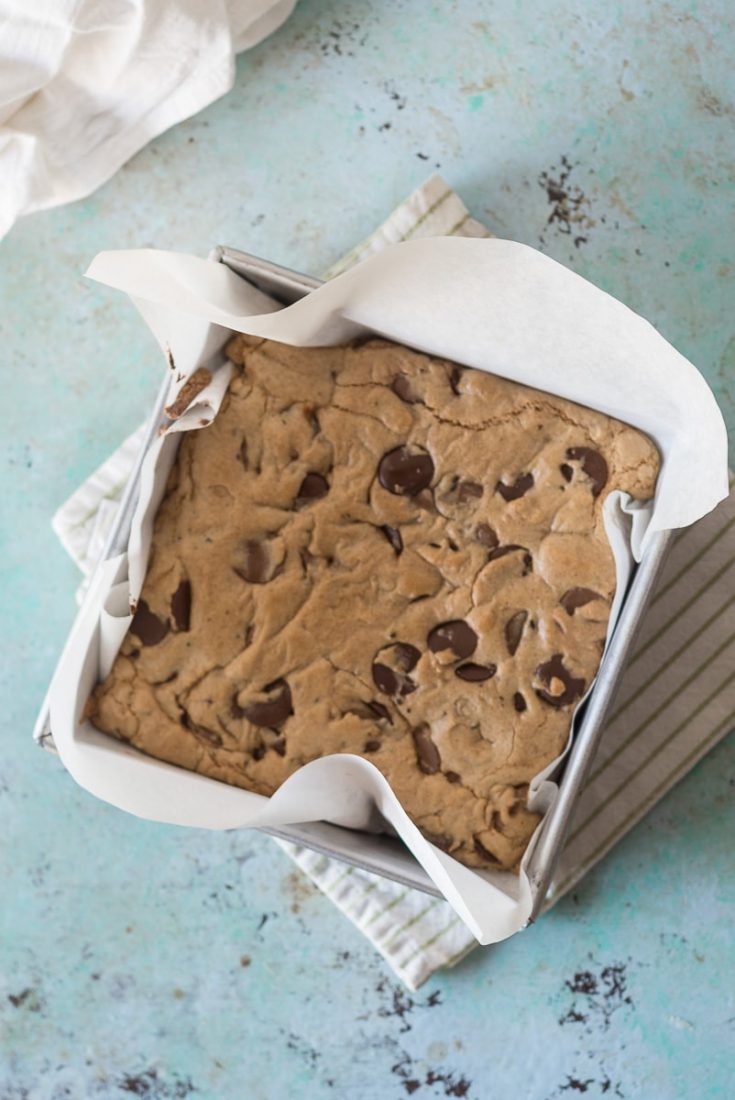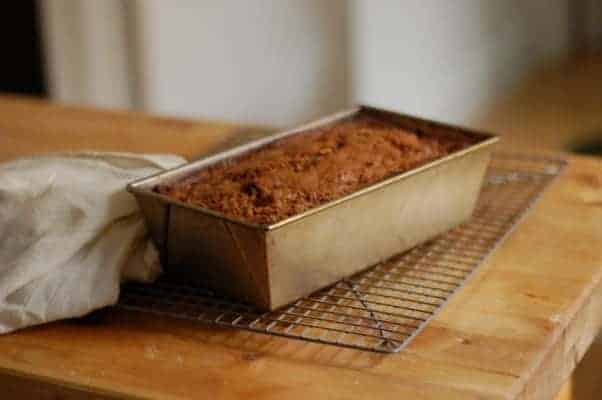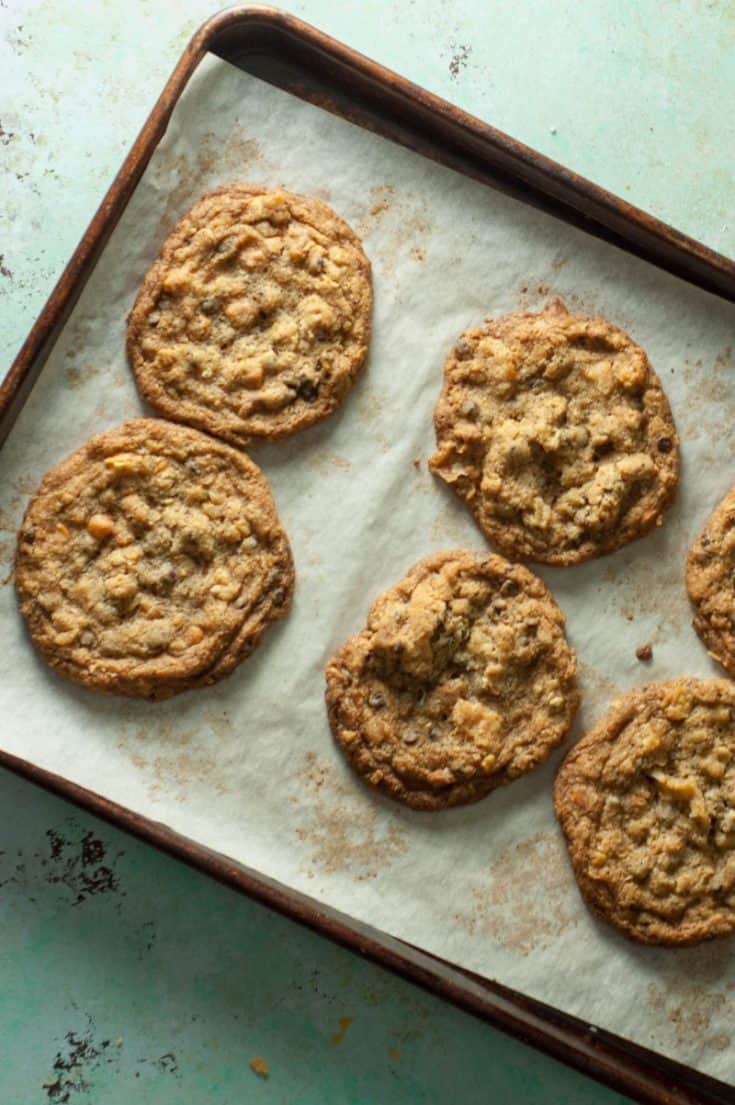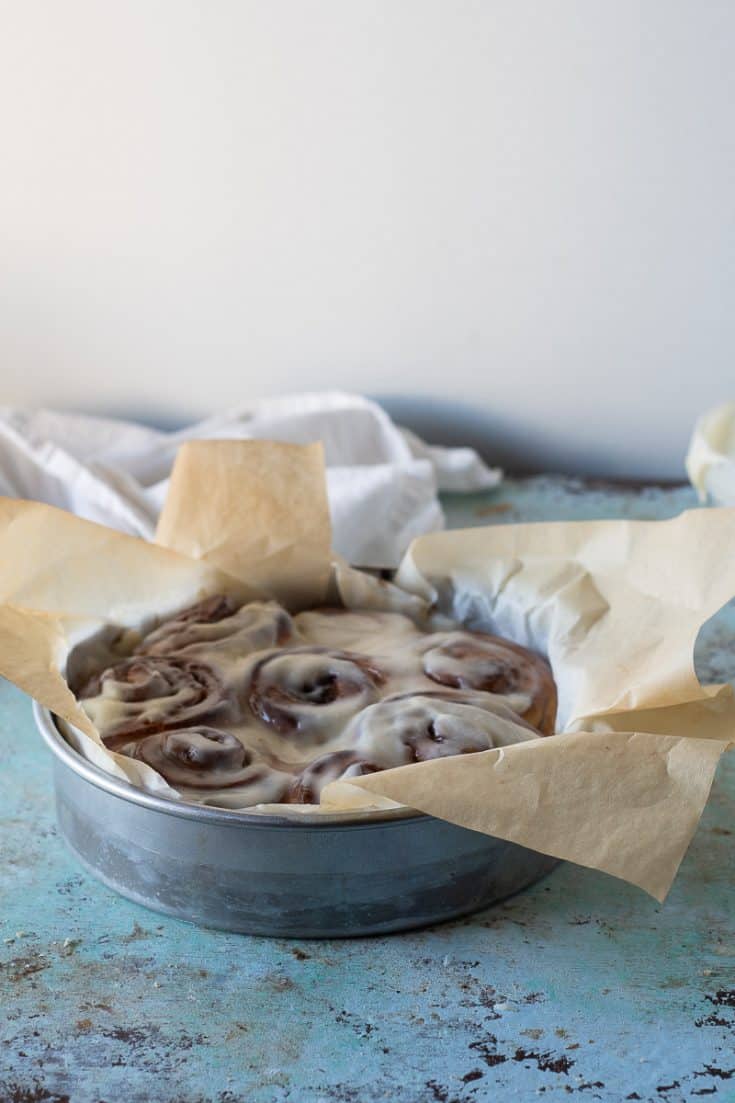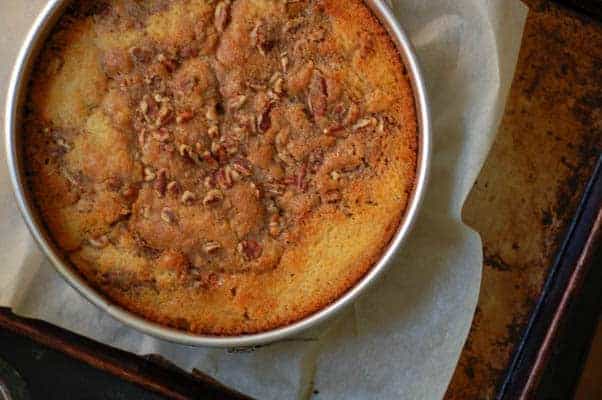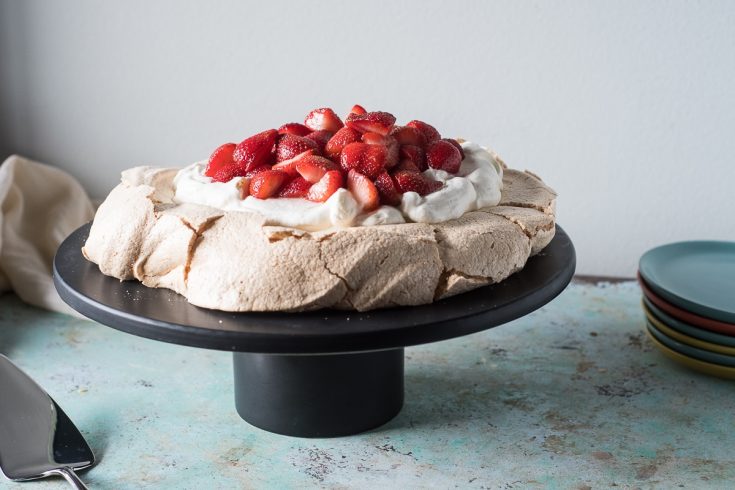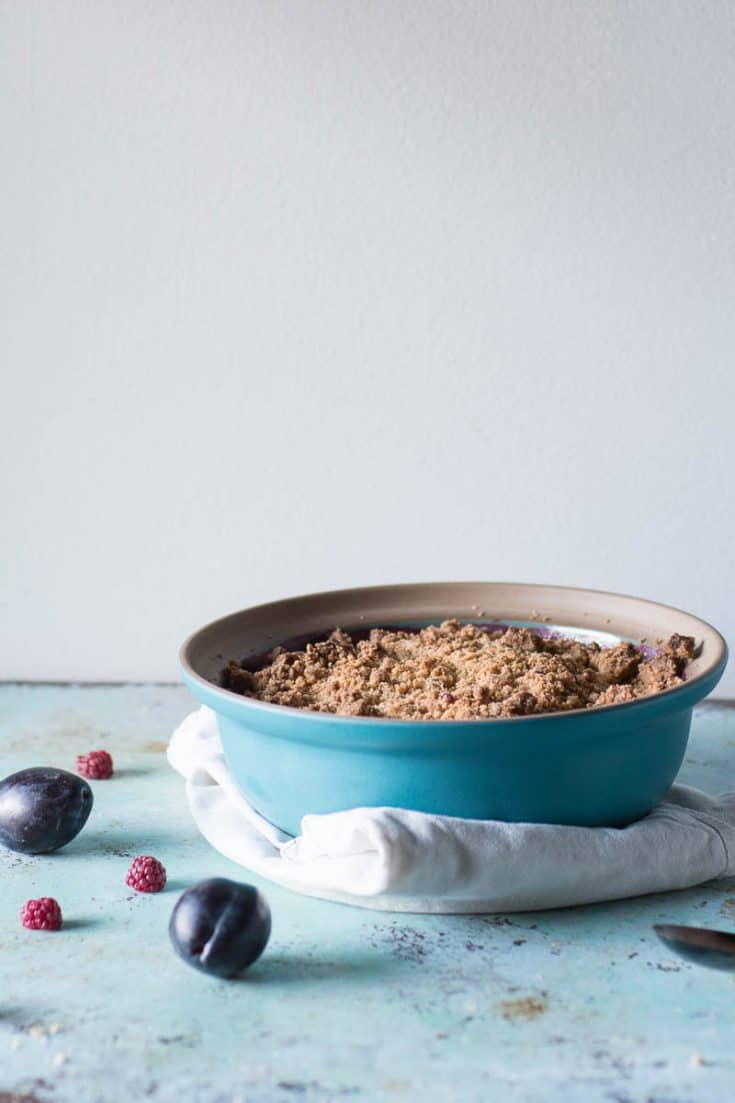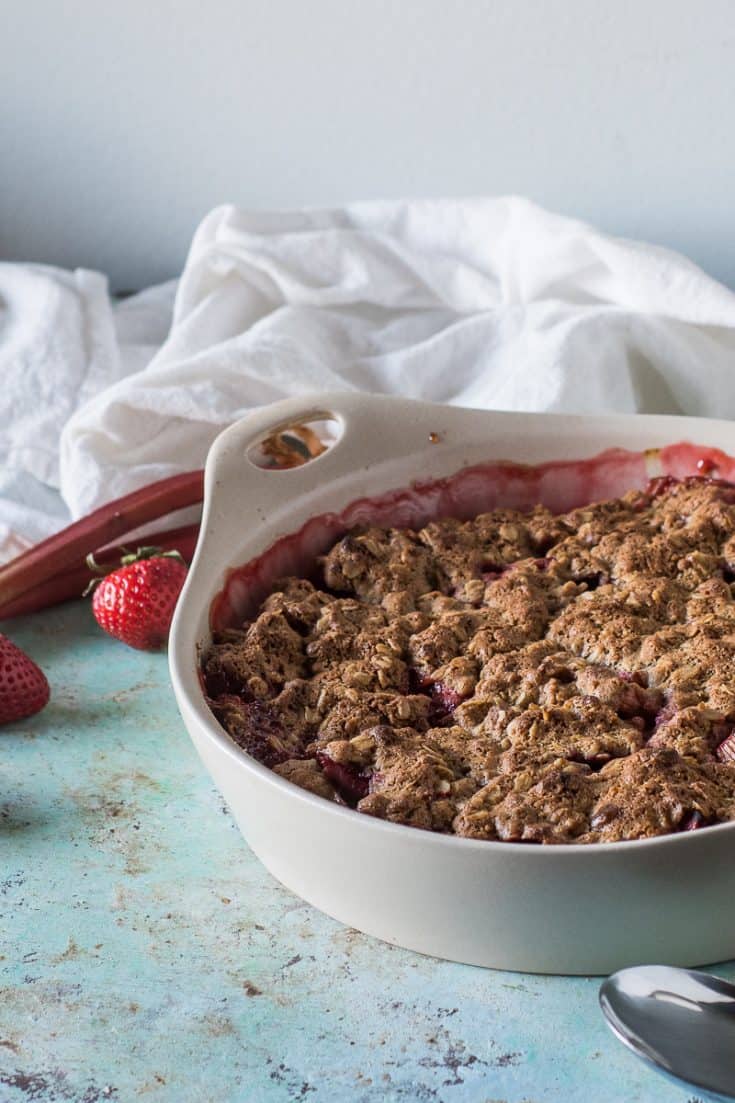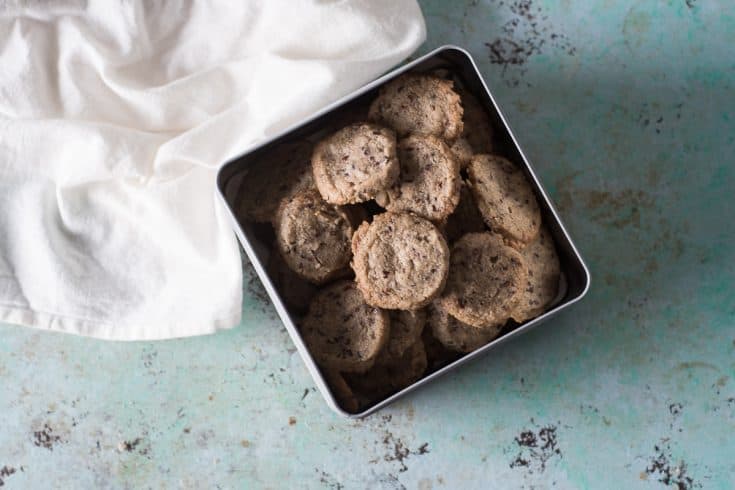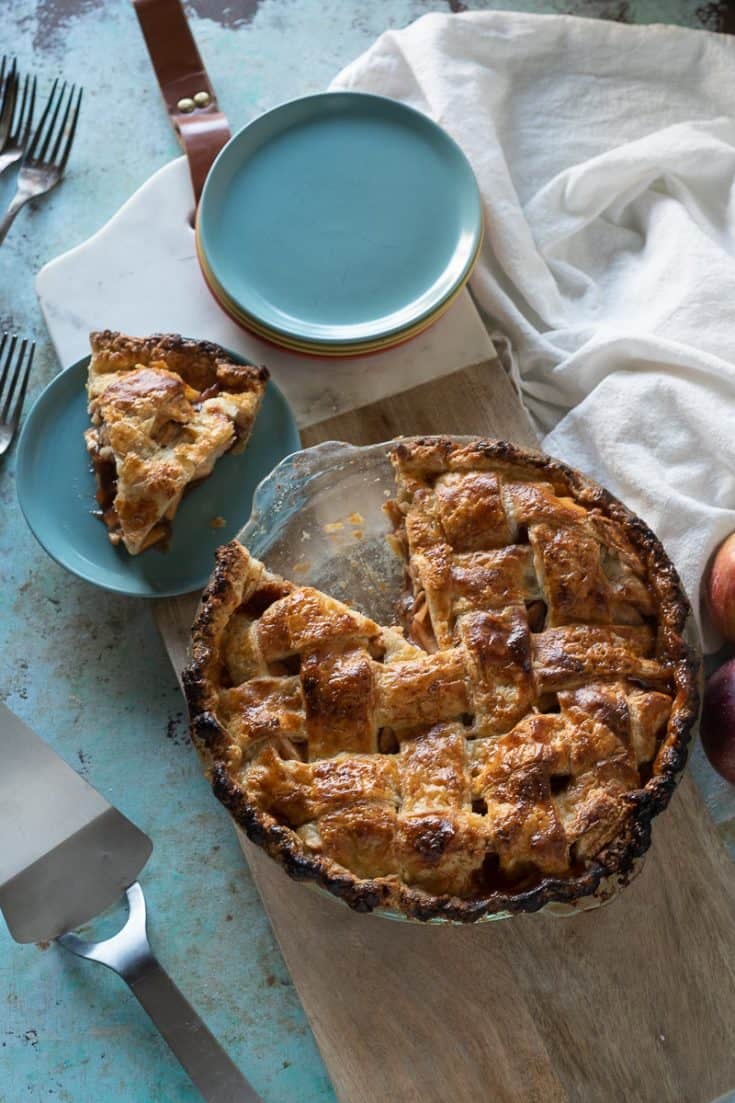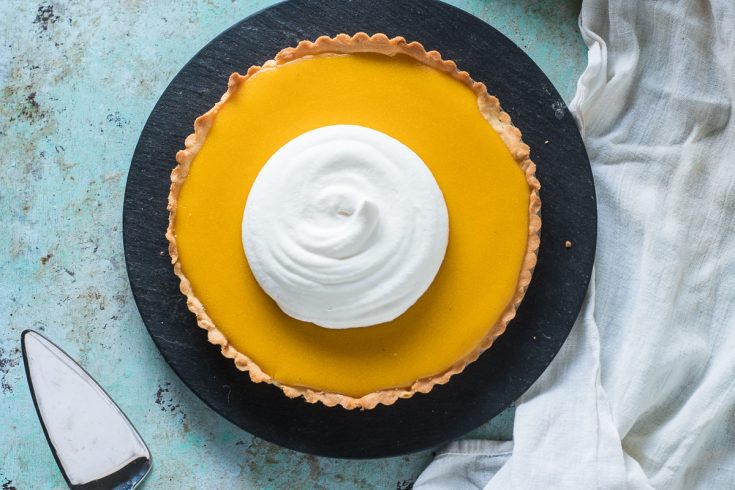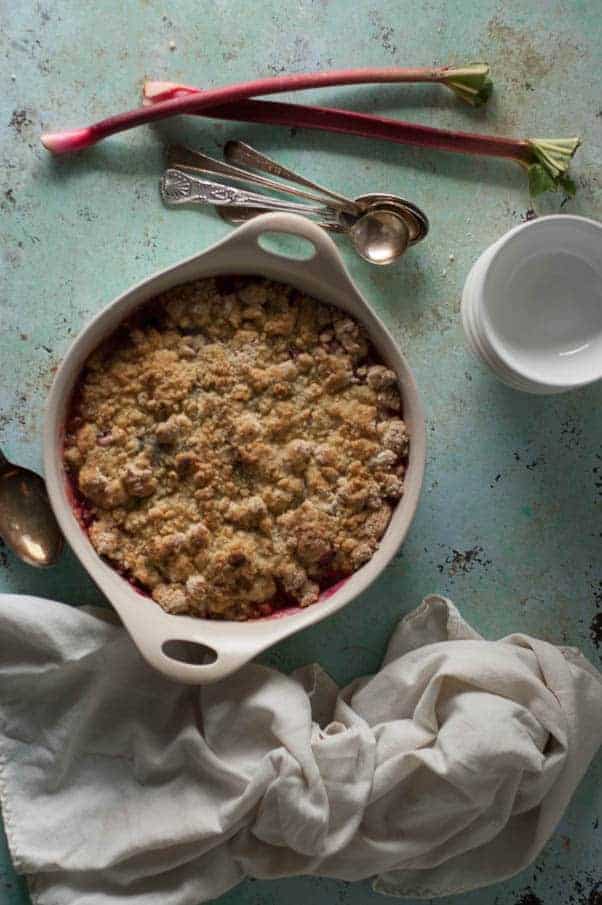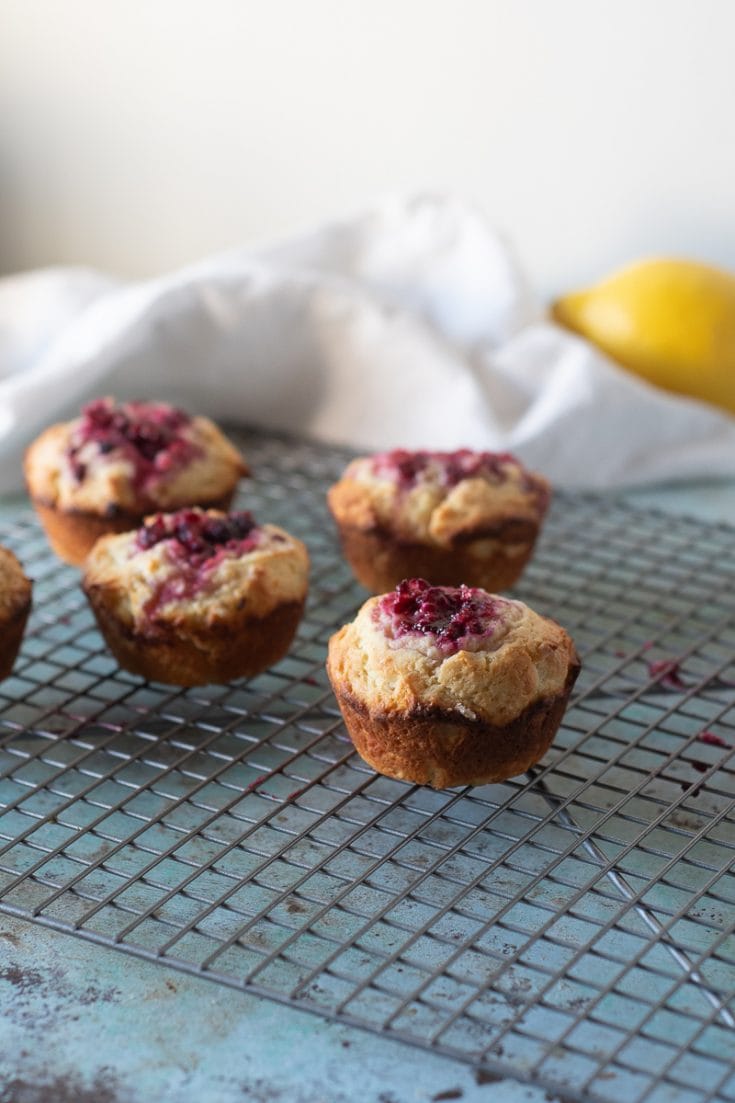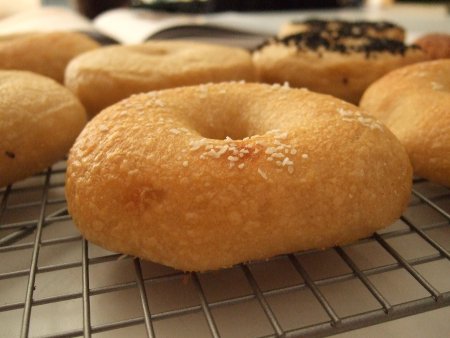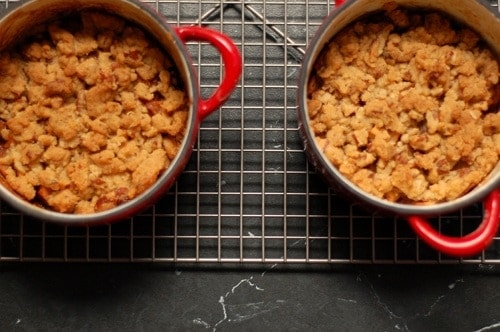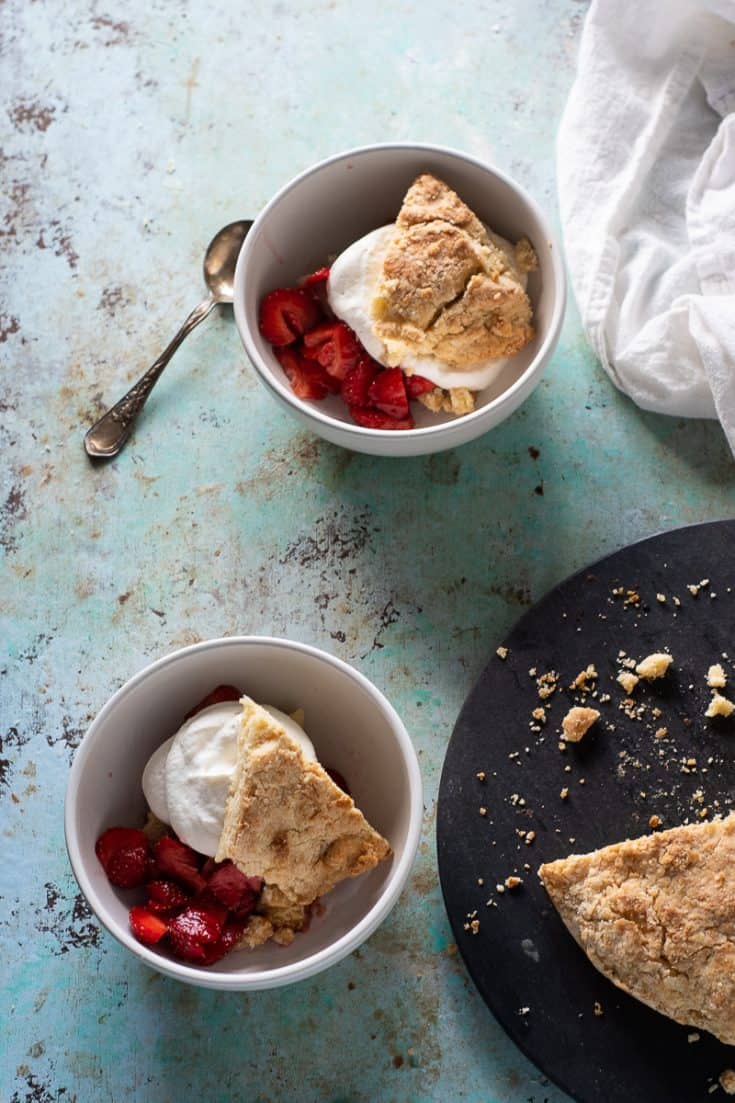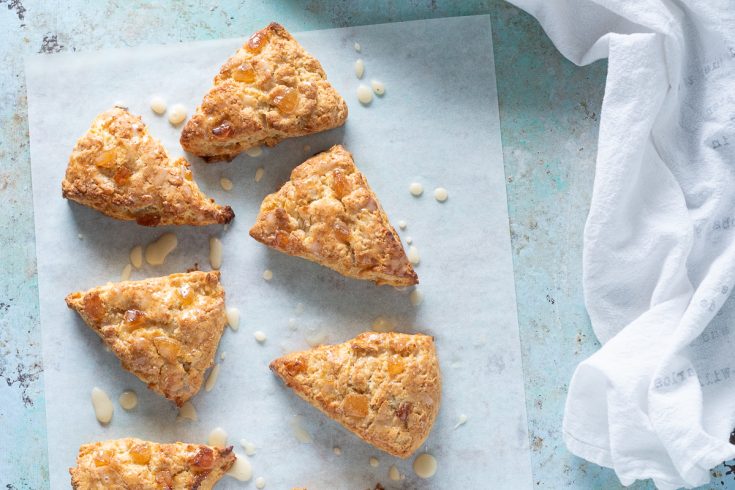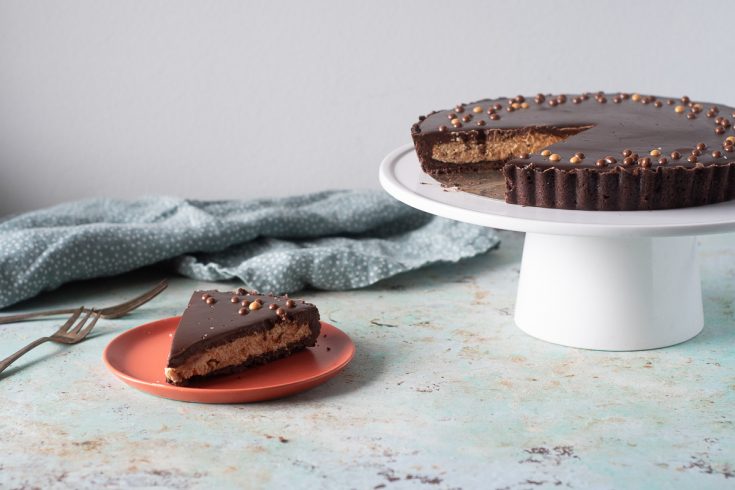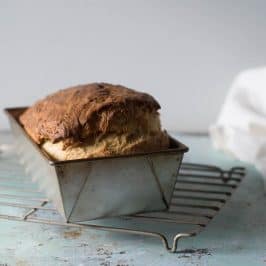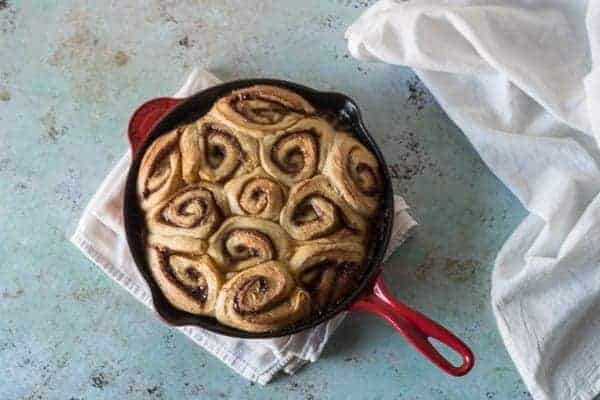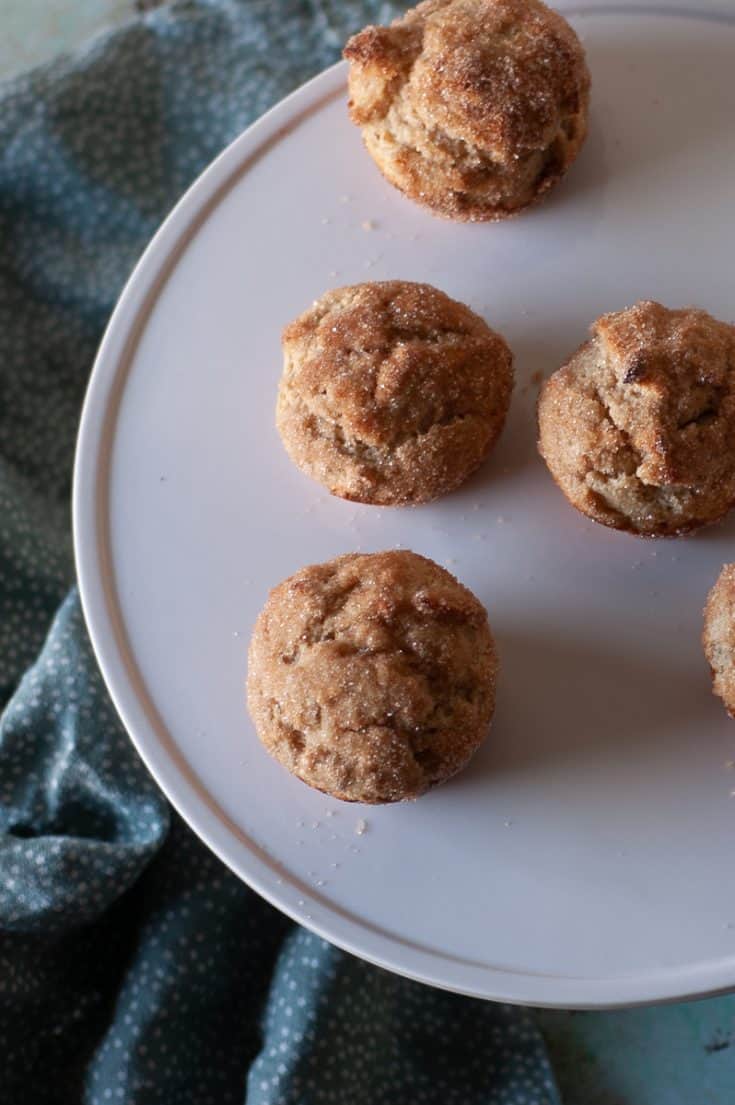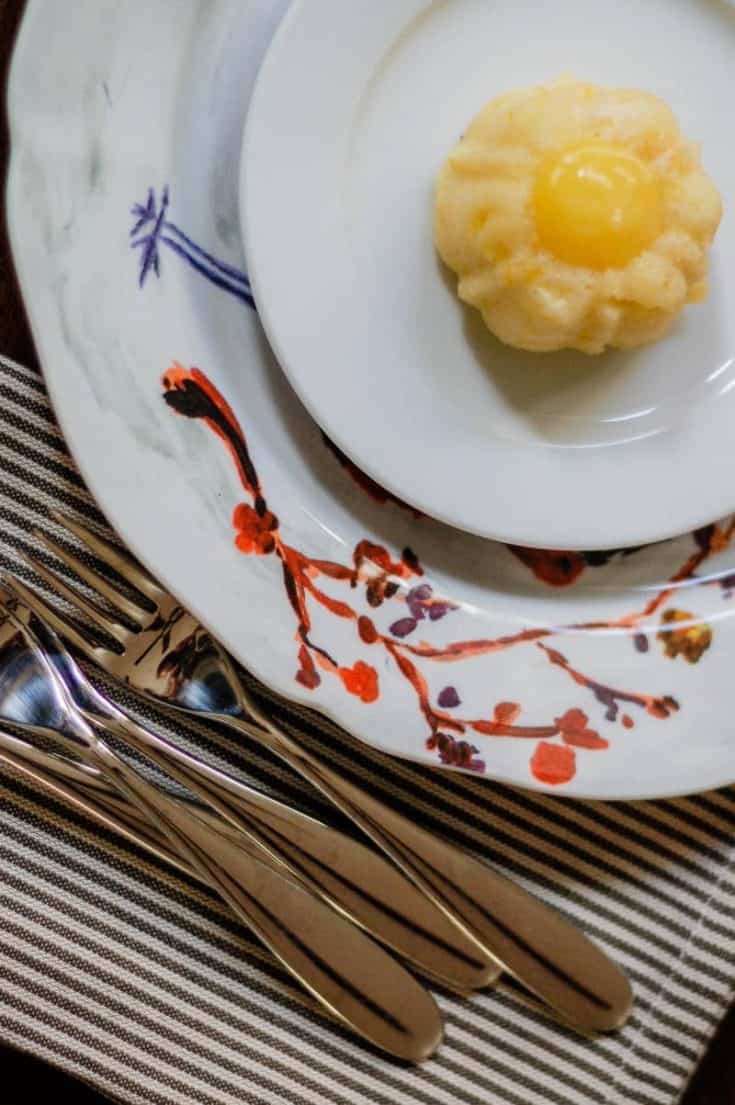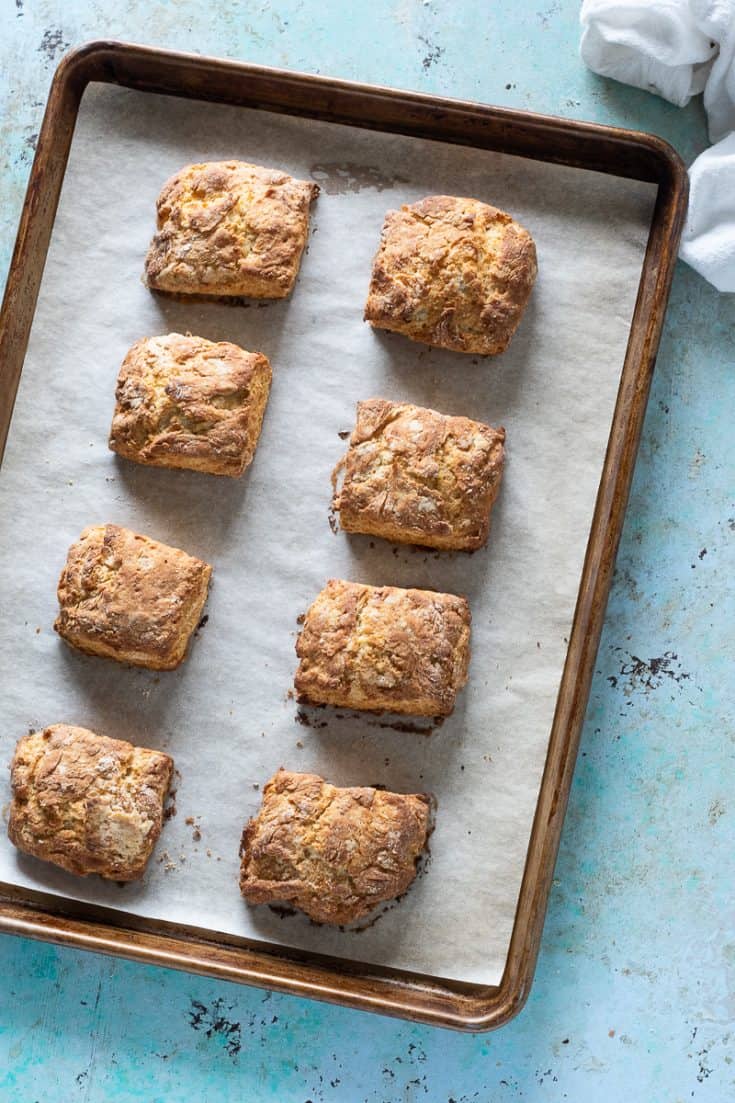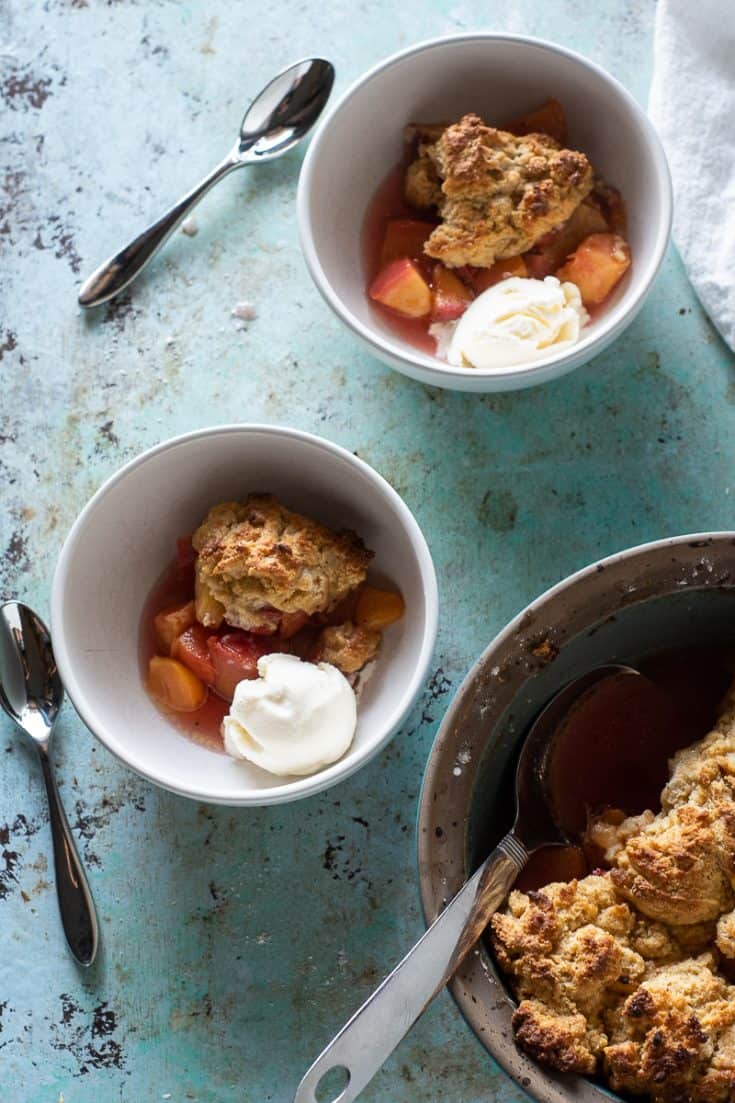I may earn from purchases through links in this post.
When you’re stuck at home, there’s little that’s more soothing and rewarding than engaging in some stress baking.
Baking is predictable. If you follow the instructions things turn out pretty well.
There’s nothing scary about it. The stakes are low. No one will die if you screw this up.
And, unless you have a major disaster in the process (a la Nailed It), you get something delicious at the end of it.
Here’s a collection of the recipes I turn to when I need to de-stress.
They include sweet and savory options. They’re generally unfussy. And they are accessible to a mediocre baker.
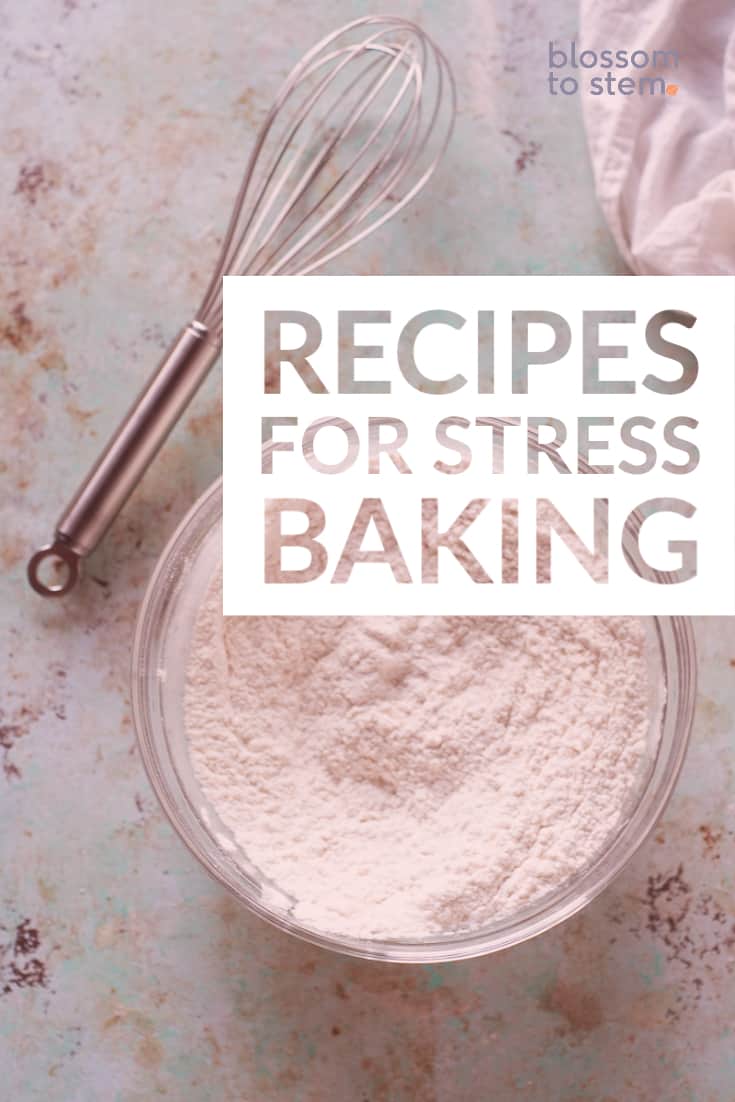
If you’re an absolute beginner with baking, the crisps and crumbles and the granola are good places to start.
You can swap out the fruit in the crisps and crumbles for whatever you have around. And you can use frozen fruit—frozen blueberries and raspberries are always good.
If you’ve baked much of anything before, you should be able to handle any of this.
The tarts are the fussiest of the lot, but if you want a bit of a challenge with a big payoff, they’re so worth it. (And you can swap out the crust in any tart for my favorite easy tart crust.)
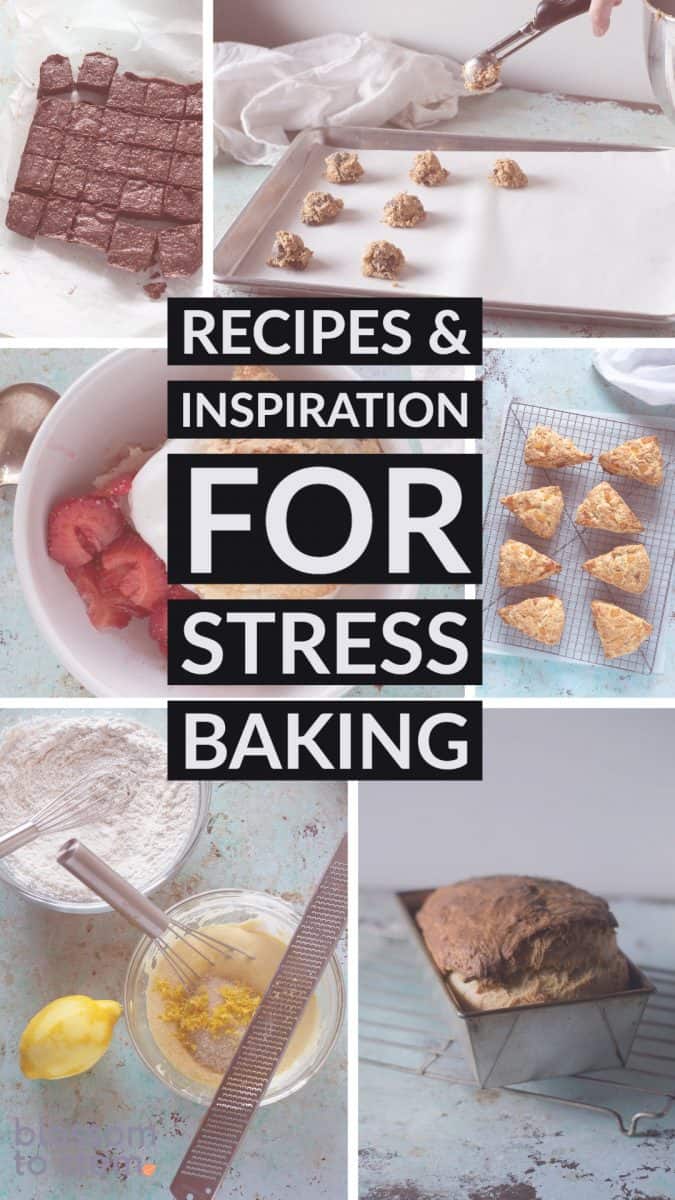
Recipes for Stress Baking
If you find yourself in need of a soothing baking project, I've got you covered!
This list of my go-tos for procrastibaking includes a range of baking projects from cookies and brownies to cakes to pies and tart, along with a smattering a breakfasty things likes muffins and scones and cinnamon rolls.
There's also a recipe for no-knead brioche, which is so ridiculously easy and good.
Most of these keep for several days or longer. Most can be scaled down (the pies and tarts are trickier) if you don't want so much around.
They aren't the kind of show-offy projects that require piping skills or rolled fondant, and they should be doable for anyone with a basic baking skills.
And don't miss the blondies. The effort-to-reward ratio on them is tough to beat.
These brownies are rich and fudgy. They get their chocolate flavor from a combination of chopped bittersweet chocolate and cocoa powder. These are quite rich, so cut them small. You can always have a second one.
This banana bread has a mix of white and brown sugar, a generous amount of vanilla, a big handful of toasted pecans, chocolate chips (you can use chopped chocolate or chocolate chips—I like bittersweet or semisweet here, but you could even use milk chocolate if you like). Best of all, it is covered with a big-crumbed, brown sugar and cinnamon streusel topping, which makes it next-level good.
These oatmeal chocolate chip cookies are chewy, oaty, and so packed with chocolate the dough barely holds it together. I like to use dark brown sugar in these for its deeper flavor, but light brown sugar will absolutely work as well. You can either chop a chocolate bar or use chocolate chips for these, but whatever you do use a chocolate you like to eat on its own. It's worth splurging on the better grocery store chocolate chips like Ghirardelli or Guittard or chopping some Trader Joe's Pound Plus. I like to sprinkle the tops with a flaky sea salt like Maldon. If you don't want to buy that, you can skip it or sprinkle the tops very judiciously with kosher salt. You can scoop the dough ahead of time and freeze it if you want to bake them later.
These brownies are one of my favorite easy-to-make desserts. They manage to combine the decadent pleasure of a fudgy brownie with the crisp, buttery, nutty texture of almond shortbread. You can pulse almonds in a food processor to make almond meal if you don’t want to buy it separately. Or you can omit the almond meal completely if you want to avoid nuts. These are quite rich, so cut them small. You can always have a second one.
These strawberry crumb bars are easy to make. The crust and topping are made from the same dough, which comes together in the food processor in about a minute. The lemon zest is nice with the strawberries here, but it is definitely optional, as is the coriander, which is incredibly subtle but enhances the strawberry flavor. The crust is crisp on the day these are made. The bars are still good for the next few days, but they definitely soften. If the weather is hot, store these in the fridge to keep them firm.
This dough needs to be made a day ahead of time (though it can hang out in the refrigerator for another four days and in the freezer for a few months). The slow overnight rise in the refrigerator allows the dough to develop a complex flavor and improve its browning and crumb structure. Bread flour helps to give pizza that pleasing chewy texture, and instant yeast lets you skip the step you find in many recipes for proofing the yeast in water ahead of time. I strongly recommend applying your toppings with a light hand. I like baking pizzas on a baking steel, which is totally worth the investment, but you can also bake it on a baking sheet. This makes enough dough for two pizzas, which means you can have pizza again later in the week or you can tuck the extra dough in the freezer and let it thaw in the refrigerator overnight the next time you want pizza.
This marbled chocolate orange olive oil Bundt cake has bright citrus flavor from the zest of two oranges.
There's some almond meal for bit of nutty richness, and espresso powder deepens the chocolate flavor. You can use either natural or Dutch process cocoa powder here. It's worth it to splurge on the cocoa powder if you have the budget—it makes a difference.
Use an olive oil that's on the milder side for this.
If you don't have Bundt pan you can bake this in two standard loaf pans. (You can also cut the in half for one loaf pan.)
This keeps beautifully for over a week, and makes an incredible breakfast cake.
I love these cookies. They call for three kinds of sugar: light brown sugar, turbinado, and granulated sugar, but you can skip the turbinado if you don't have it and just use more brown sugar in its place. I love the toasty oat flavor that oat flour brings, but you can use all all-purpose if you don't want to bother. You can make these with all chocolate chips or any mix of chocolate and butterscotch chips you like, just use a pound total (I recommend looking for good quality chocolate chips like Guittard or Ghirardelli, but use whatever you like). So I'm saying these are incredibly flexible. They get even better if you let the dough rest overnight, but if you want cookies right now (and who doesn't) you can go ahead and scoop them and bake them right away. They really benefit from a generous sprinkle of flaky sea salt on top before they go into the oven (I'm partial to Maldon). Also, your life will be easier and your cookies will all be the same size (and pair up easily for ice cream sandwiches) if you use a medium cookie scoop (aka #40 disher).
These unfussy cookie bars have a base of rich, buttery brown sugar cookie, then a layer of semisweet or bittersweet chocolate, all topped with a layer of caramelized rice cereal.
Caramelizing the Rice Krispies (or whatever puffed rice cereal you choose) involves making a simple caramel in a wide skillet and tossing the cereal in the caramel to coat it. It's an optional step (you can just use plain cereal if you don't want to bother with the caramel), but it makes the bars extra special if you're willing to do it.
I like to use bittersweet chocolate here to help balance the sweetness of the cookie base and the topping, but semisweet chocolate works well here. You can get away with using chocolate chips if you want, though I think chopped chocolate melts a little bit easier.
These blondies get depth of flavor from brown butter, graham cracker crumbs, instant coffee, and double the usual amounts of vanilla and salt. They have what might seem like too much chocolate, but I think it’s just right. The chocolate pictured is a mix of Guittard milk and semisweet baking wafers, but you can use any mix of chocolate chips or chopped chocolate you like. If you’re at the grocery store, keep an eye out for Ghirardelli or Guittard chocolate chips. I like to bake these in an 8×8-inch baking pan to keep them thick and soft. These are quite rich, so I cut them small to keep them manageable.
This is a lovely banana bread with a classic flavor profile. You can make your own oat flour by pulsing rolled or quick oats (but not steel cut) in a food processor or you can use a commercial oat flour. You could substitute all-purpose or whole wheat flour for the oat flour and it would still work, but I really like the homey oat flavor here. This is one of my favorite kinds of banana bread to have for breakfast. It feels wholesome enough that I don’t mistake it for dessert. You can freeze overripe bananas if you want to keep them around for whenever the urge for banana bread strikes. [Update: I just tested this using all oat flour, and it was great. It would be a great gluten free option for banana bread. It's a little more delicate than the part-wheat version. You could add a little xanthan gum for extra stability. Oats don’t contain gluten, but they’re often contaminated with wheat in processing, so be sure to make sure you’re using certified gluten free oat products if you’re making this for someone with gluten sensitivities.]
These are a worthy entry into the broad category of cookies with a hodge podge of add-ins sometimes called “kitchen sink cookies” or “garbage cookies.” The add-ins are flexible and can be adjusted to suit your tastes. These cookies need to chill at least an hour before baking, so plan ahead. I prefer to chill them overnight. These are big cookies, more along the lines of the size of cookies you often find at bakeries than those that usually come out of home ovens. Be sure to give them plenty of room to spread in the oven–only 6 cookies fit on a half sheet pan. These make amazing ice cream sandwiches.
These morning buns pretty quick for anything involving a yeasted dough. They're warm from the oven about 90 minutes after you start them. You'll need to use instant yeast here (I like SAF Red Label), which can be mixed right in with the flour. Don't use active dry yeast, which needs to be proofed in liquid first. The filling is a simple mix of butter, brown sugar, instant espresso, and ground cardamom. The crème fraîche icing is rich with a generous hit of vanilla and a pleasant tang. You can make it with vanilla extract or, if you want to go the extra mile, swap in vanilla bean paste. (The Vermont Creamery Crème Fraîche with Vanilla Bean would also be a natural fit here.)
These brown butter apple bars occupy the space between a tart and a cookie. Their base is one of my all time favorite shortbread crusts, that’s buttery, crisp, easy and has never let me down. You can brown the butter for the crust as well if you want more of that nutty brown butter flavor. The brown butter custard layer is infused with a cinnamon stick and has caramel-molasses notes from the brown sugar. When most home cooks need to slice apples, they start by slicing them down the middle through the core and then quarter them and remove the core from each wedge. One thing I’ve observed through watching many chefs in action is that most professionals slice apples by cutting the apple on each side close to the core leaving a square core and four pieces of apple that are easy to slice. Not surprisingly, the professional way is more efficient, and it’s the method I recommend for slicing the apples for this recipe. You can use any firm baking apple you like for these. I used Fuji apples here. These are best the day they are made, but can keep well in the refrigerator for a couple of days.
This buckle is a rustic fruit-laden cake. It would work with just about any combination of stone fruit or berries. The buttermilk helps to tenderized the crumb and adds a tangy note to balance the sweetness of the cake. You can skip browning the butter if you’re in a hurry, but if you do have the time, I suggest giving it a try. It adds some nice depth of flavor. Peaches should be peeled before going into this–the easiest way to peel very ripe peaches is to blanch them in boiling water for about a minute and then run them under cold water–the skins should just slip off. The skins of most other stone fruits are thin and tender enough that they don’t need peeling. I like to use turbinado (raw) sugar in the streusel topping, but any granulated sugar is fine.
Strawberry pavlova is a traditional Australian dessert. This one gets punched up with a bit of smoky mezcal and citrusy lime. It's a dessert that can sometimes be too sweet, so I cut back on the amount of sugar you find in some versions, and I love to use lightly toasted sugar here. It's optional, but it brings in great caramel notes. You can, of course, skip the mezcal and/or the lime if it isn't your thing, but if you like smoky flavors you owe it to yourself to try the combination. This is a dessert that's best served soon after making.
This almond anise plum torte is inspired by Marian Burros famous plum torte. It's a rustic dessert with a hefty crumb. The flavors here are inspired by classic Italian biscotti. You can use either ground star anise or anise seed for the anise flavor here (and of course haters can omit it altogether). This works best with small oblong plums that tend to be around in the early fall.
This crisp is a cinch to put together. Look for oblong Italian plums (sometimes called prune plums) or tiny Damson plums for this--they're my favorite varieties for baking. If you don't want to use raspberries you can use an equal amount of plums. When you melt the butter, you can take the extra step of browning it for more flavor (I usually do)--it brings out the nutty flavor and is really delightful--but it's not necessary.
This strawberry rhubarb crisp is made with a mix of oat flour and old fashioned rolled oats. It's 100% whole grain and gluten free. (If you're making this for someone intolerant to gluten, be sure to look for certified gluten-free oats and oat flour because oats are often processed in facilities that also process wheat and can be cross contaminated.) The topping comes together in a few minutes. I sometimes like to take the extra step of browning the butter when melting it, but I leave that entirely up to you. I like the mixture of strawberries and rhubarb, but you could absolutely make this entirely with rhubarb with no other adjustments to the recipe.
This apple pie is everything I look for in a classic apple pie. The crust is flaky, the filling is sturdy enough to slice but gooey enough to feel rich. It's got a mix of white and brown sugar for depth of flavor and a generous amount of cinnamon to keep the flavor profile simple and classic.
My favorite apple pies are made with a mix of apple varieties like Empires, Cortlands, Liberty, and Northern Spy. But if you are limited in what apples are available to you, Granny Smiths are a solid option.
Don't use Honey Crisp or other extra sweet and juicy apples—they're too sweet to handle extra sugar and their texture is too soft to hold up in baking.
The apples in this pie retain a bit of a firm bite. I like them that way, but if you want your apples totally soft, slice them thinner than I do here.
This passion fruit tart is one of my all-time favorite desserts. It's like a lemon tart (or lemon meringue pie) but better. The tart crust has a lighter, airier texture than most because of the long creaming time. This makes it more delicate and rustic than some might prefer, but I love it. That said, if you have go-to tart crust or pâte sucrée, feel free to use it. I tend to use frozen passion fruit puree for this. It's often available at Mexican grocery stores and at some big chains. I usually use Goya brand, but I'd recommend sticking to a brand that lists passion fruit as the only ingredient. (You can also order it online.) If you have fresh passion fruit, though, you can absolutely use them. Just slice open the fruit, scoop out the pulp and remove the seeds and use it here.
This tart doesn't need any adornment, really, but I like to top it with some lightly sweetened whipped cream.
You'll need a 9.5-in tart pan and a half sheet pan for this recipe.
This crumble comes together in minutes. The rhubarb gets tossed with sugar and orange zest and topped with a craggy vanilla bean-scented brown butter lid. If you don’t have a vanilla bean on hand or don’t want to drop the cash on one, this will still be delicious though slightly less complex with a teaspoon of vanilla extract mixed in with the brown butter after you take it off the heat. You can substitute your favorite all-purpose gluten free flour mix (I like Cup4Cup and Bobs Red Mill Gluten-Free 1-to-1 Baking Flour) if you’d like to make this gluten free. This is an incredibly flexible recipe. You can skip the orange zest if it’s not your thing, or you can add a pinch of cinnamon or ground ginger if you’re in the mood for it. This is good warm from the oven with a scoop of vanilla ice cream. It’s also great at room temperature (which makes it a good option for a dessert to bring to a late spring/early summer cookout). I also love it cold from the refrigerator. As I said, really flexible.
These raspberry lemon muffins are, at heart, lemon muffins with jammy raspberry middles. The fats in this batter come from olive oil (choose a mellow one) and Greek yogurt. I recommend full-fat or 2% here for the best texture. Be careful when removing the muffins from the tin--the raspberry middles can get a bit messy. You can turn them out and accept a little mess or carefully remove them one by one from the muffin tin, your call.
The key to the right texture here is high-gluten flour. I had trouble finding it in Chicago, but I was fortunate enough to have some generous benefactors (Dan's parents) send some my way. It is available online from the King Arthur Flour Baker's Catalogue. You may also substitute bread flour, according to Reinhart, who cautions that it won't be quite as chewy. I've had good results with barley malt syrup, which is available at most natural foods stores. Reinhart recommends using diastatic malt powder, which is also available from King Arthur Flour. In a pinch, honey or brown sugar will also yield tasty, if not quite characteristically bagel-like, results.
This is granola is almost always present in my kitchen. When I run out of it, I don’t quite know what to do for breakfast, so I quickly go out to get the ingredients to make more. Granola is so easy to make, and it’s easy to scale up or down to suit your needs (I usually make a double batch). The real maple syrup is essential to the flavor here. It looks like a lot, but this granola isn’t too sweet. I look for the darker, more flavorful grade B maple syrup when I can find it. The vanilla bean is nice, but I’ve made this with vanilla extract and it’s still delicious. I discovered that I get better clusters when I use half of the finer quick oats along with the old fashioned rolled oats. If you don’t want to buy two kinds of oats, you can zizz some rolled oats in a food processor to approximate quick oats. Look for unrefined coconut oil, which has more coconut flavor than the refined versions. This is vegan as is and it could be gluten free if you use certified gluten free oats. Because nuts can go rancid, I like to store this granola in the refrigerator to prolong freshness.
This recipe works best in 2 cup stovetop and oven safe cookware (such as these mini enameled cast iron dutch ovens), but if you wish to make these in large ramekins or other small baking dishes, you may skip the stove top caramelization step and simply bake them for an extra ten minutes or so. It won’t give you that deep caramel flavor, but it will still be delicious. You may of course, use these techniques with other fruits or with your own favorite crumble or crisp topping. This works best with slightly tart apples that work well for baking. I like to use a mix of apples and in this case used a spigold, a spuree rome, and a macoun, but feel free to use any apples you like.
This strawberry shortcake makes one big biscuit-style shortcake that gets cut into wedges. It's a tender and flaky shortcake that's rich with butter and heavy cream and barely sweet. I usually slice the strawberries and toss them in sugar while the shortcake is in the oven, but you can make them a day ahead of time and keep them in an airtight container in the refrigerator if you prefer. Wait to whip the cream until you're ready to serve the shortcake. I prefer to use an all-purpose flour with a mid-range protein content like Gold Medal for the shortcake. This will work with a higher protein all-purpose flour like King Arthur, but it won't be quite as tender. (And southerners, I'm sorry to say I don't have easy access to White Lily, so I don't know how that will work here, but if you try it, do report back!)
These scones are similar to the ones you find in American bakeries. They're crisp on the outside, tender on the inside with a dense, close crumb. They are enriched with butter and cream and raised with baking soda. The combination of orange zest and crystallized ginger is lovely here, especially with the tangy vanilla-scented crème fraîche icing. If you don't want to bother with icing (though, really, you should, this one is so easy and good), sprinkle the wedges of dough with sugar before baking.
This chocolate peanut butter tart is like a giant peanut butter cup with a crisp chocolate shortbread crust, a light peanut butter mousse filling with whipped cream and crème fraîche (that I could eat with a spoon on it's own). I like to use Skippy (or a similar style) creamy peanut butter rather than an all natural peanut butter because I find it blends better. I recommend using a high quality cocoa powder in the crust like Valrhona or Droste rather than the really cheap stuff (it's a place where splurging a little makes a big difference). I go for a chocolate in the 60-60% cacao range in the ganache, but it will work with any percentage of milk or dark chocolate you like (but I'd avoid chocolate chips which are made with additives that prevent melting smoothly). This tart is rich, so I like to serve it in small slices (10-12 slices per tart) but you do you.
This is the easiest way to make melt-in-your-mouth buttery brioche. It's worth it to go to the trouble of browning the butter for this--it'll make the flavor that much better. I like to throw in a vanilla bean while the butter is browning, but that's a lily-gilding step that's totally optional. It's also worth splurging on a nice high-fat European butter like Plugra or Kerrygold for this, though it will still work and be delicious with any unsalted butter. Look for instant yeast and not active dry. I'm partial to SAF red label instant yeast. This recipe will work with bread flour or all-purpose flour. It's a big recipe that pushes the capacity of my biggest mixing bowl. You can easily cut it in half if you only want one loaf. But keep in mind that the dough and the baked loaves freeze well, so you'll thank yourself later if you make the whole batch.
These cinnamon rolls use the simplest no-knead brioche dough, which is an amazingly versatile dough for rich breakfast treats. The dough needs to rest overnight, so be sure to plan ahead, but relax knowing that there's hardly any work involved. These cinnamon rolls can be assembled the night before and covered and refrigerated overnight and baked in the morning for your convenience--they'll just take an extra few minutes to bake. The delightful richness of these cinnamon rolls mean that leftovers hold up well (not that you'll have any). I like to bake them in a cast iron pan which keeps them warmer for longer, but any 10-inch round pan will work.
I love making muffins with alternative flours, which offer such a wealth of flavor options. Oat flour is one of the easiest to come by–you can make it by zizzing rolled oats in a food processor until they’re finely ground. If you are making these for someone with gluten sensitivity, be sure to look for oat flour or rolled oats that are certified gluten free (oats are often processed on equipment that also handles wheat). I like to make these with a pourable French-style yogurt, but they also work with Greek yogurt or kefir–I like them best with full fat, but low fat options also work. The muffins are a little fragile while they’re warm, so be gentle while rolling them in the cinnamon and sugar. You could make these with all-purpose flour if you prefer (just substitute the flour one for one and omit the xanthan gum).
These cakes are lemony and tender and moist. They can be made in a standard Bundt pan (in which case bake for an hour), in mini Bundt cake molds, or even a muffin pan. I used a 12-cavity pan, which makes mini cakes about the size of standard muffins. The curd topping is optional, but please don’t skip the glaze. It really completes these cakes. If you only have small lemons, you can use two of them in place of one large one in these recipes. If you don’t feel like making your own Meyer lemon ginger curd, you could use a high quality prepared lemon or passion fruit curd (such as those made in Oak Park by Rare Bird Preserves).
These buttermilk biscuits are light and flaky and buttery. I prefer to use an all-purpose flour with a mid-range protein content like Gold Medal for these biscuits. Avoid a higher protein all-purpose flour like King Arthur, which will result in biscuits that aren't quite as tender. (And southerners, I'm sorry to say I don't have easy access to White Lily, so I don't know how this particular recipe works with that, but if you try it, do report back!) Avoid buttermilk substitutes for these biscuits—it's essential for the flavor—but if you must use something else kefir is the next best option. This is also designed to work with American-style unsalted butter (higher fat European butters will cause these to spread more and not rise up so beautifully).
This peach cobbler is a great way to use up peaches that are a little overripe or imperfect. There's no need to peel the peaches, though if you're sensitive to peach skin you can blanch the peaches in boiling water briefly and then run them under cold water to slip off the skin. This cobbler has a fluffy buttermilk biscuit topping with a bit of cornmeal for a pleasing nubbly texture. I prefer a fine-to-medium grind of cornmeal here rather than a coarse grind here.

